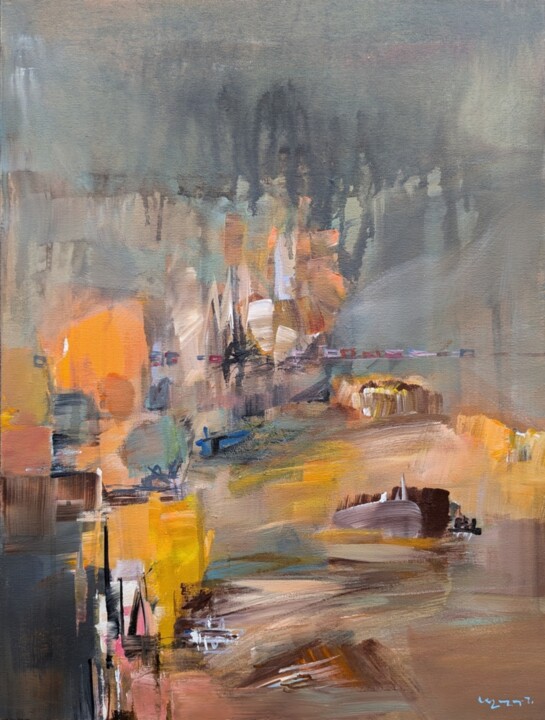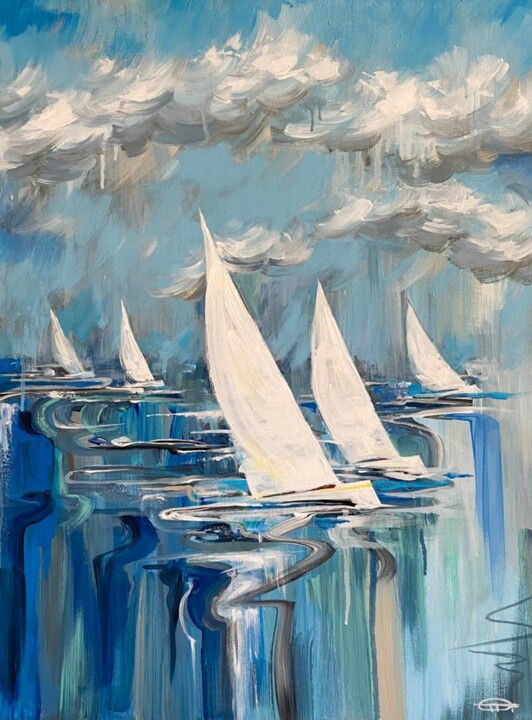Landscapes, Coffee, and Strokes of Genius: The Discovery on ArtMajeur
The scene is almost comical when viewed from the outside. A researcher, hunched over her desk, scratches her head thoughtfully, searching for the perfect idea to make a seemingly straightforward topic interesting: discussing landscapes, views, and seascapes. A mission that many would call predictable, almost obvious. But she doesn’t give up. She alternates between glancing at the monitor and taking long sips of coffee, while her mind weaves and unravels threads of thoughts in search of an original approach.
And yet, the answer is right there in front of her eyes, on the screen—and not just hers: it’s already in front of every visitor to ArtMajeur’s website. An infinite art marketplace where landscapes are not limited to the classic flower-filled fields immortalized by Monet—“rest his soul,” she murmurs with a smile—but expand in every imaginable direction. Mountains, majestic and solemn; deserts, places of light and solitude; forests, dark and full of mystery. These are the subjects that, along with seascapes, maritime paintings, and urban views, tell a broader, contemporary, and profoundly real and diverse vision of the world.
Now the researcher laughs to herself, happy and almost relieved. Nothing could be simpler, clearer, or more perfect: to tell the story of ArtMajeur’s landscapes as they are, exploring every facet, every emotion, every story.
Let the journey begin!
Landscapes
Fields
 After the rain... (2020) Painting by Ans Duin
After the rain... (2020) Painting by Ans Duin
"After the Rain" by Ans Duin depicts a countryside landscape just after an intense rainfall. The meadow appears fresh and lush, while dark gray clouds still linger on the horizon, almost promising that their rumbling thunder might still echo for a few hours.
The work aligns with an artistic tradition that, far from the sunlit fields of Impressionism, explores darker and more intense themes. Cloudy landscapes, dramatic skies, and transitional atmospheres have inspired artists across various historical movements, from the Romantics to the Post-Impressionists, the Baroque to the Expressionists.
A remarkable example of a dark landscape in the Romantic tradition is Caspar David Friedrich's Morning in the Riesengebirge. This painting depicts a mountainous scene immersed in the cold light of dawn and shrouded in low clouds, evoking a sense of solemn quiet and melancholy. Like other Romantics, Friedrich uses the landscape to explore the sublime—that feeling of awe and unease that humans experience in the face of nature's grandeur.
Similarly, the American artist Thomas Cole, in his work The Oxbow (1836), explores a nature that is not entirely idyllic. While celebrating the American landscape, Cole contrasts a sunlit, fertile side of the river with a wilder, stormier section marked by dark clouds. This duality reflects the tension between civilization and untamed nature.
Among the most iconic paintings of dark landscapes is View of Toledo (c. 1596-1600) by El Greco. This Baroque vision of the Spanish city under a stormy sky creates a surreal, almost mystical atmosphere. The composition conveys a sense of isolation and unease, which aligns with the artist's intense spirituality. The use of dark colors and tumultuous skies is characteristic of the Baroque style, which often dramatized reality and emphasized emotional aspects.
In the Netherlands during the 17th century, artists like Jan van Goyen produced works such as Sandy Road with a Farmhouse, which introduced dark landscapes dominated by gray skies and melancholic atmospheres. This type of representation was typical of painters from the Dutch Golden Age, who sought to capture the simplicity of everyday life and the ever-changing weather conditions of the Dutch countryside.
Within the Post-Impressionist context, Vincent van Gogh stands out for his use of dark landscapes to express deep emotions. Wheatfield with Crows (1890) is a famous example: the crows flying under a menacing sky suggest a sense of foreboding and unease. The movement of the brushstrokes and the dramatic use of color amplify the psychological impact of the painting, turning the landscape into a window into the artist's troubled soul.
The reason why artists from such diverse movements—Romanticism, Baroque, Post-Impressionism, and the Dutch Golden Age—chose dark and stormy atmospheres lies in their view of nature as a reflection of human interiority. Cloudy skies, storms, and melancholic scenes embody the sublime, mystery, and the vulnerability of humanity when confronted with the world.
Thus, it becomes clear how Ans Duin, with her After the Rain, fits seamlessly into this long artistic tradition.
Mountains
 composition N3 /rainy mood (2024) Painting by Armen Ghazayran (Nem)
composition N3 /rainy mood (2024) Painting by Armen Ghazayran (Nem)
 YeY 24 (2024) Painting by Armen Ghazayran (Nem)
YeY 24 (2024) Painting by Armen Ghazayran (Nem)
 My mountains / in memory 24 (2024) Painting by Armen Ghazayran (Nem)
My mountains / in memory 24 (2024) Painting by Armen Ghazayran (Nem)
Why did I juxtapose three paintings by the same artist? It's a legitimate question, and the answer likely lies in how my imagination interpreted them as a consecutive visual narrative. Perhaps influenced by Cézanne’s pictorial exploration of mountains, I wanted to see a progression in these works: a journey from abstraction to concreteness.
The three paintings create an imaginary sequence, like three stages of an artistic journey. It begins with an abstract, undefined mountain, where the form dissolves into colors and painterly gestures. It continues with a mountain featuring "Cubist" traits, divided into sections and brought very close to the observer, almost breaking the landscape apart to study it from within. Finally, it arrives at the third piece, characterized by Fauvist colors and occasionally Impressionist stylistic elements, creating a clear image of the tangible reality: the mountain is there, tangible, with all its power and beauty.
The fascination with mountains is certainly not new. Throughout history, many artists have drawn inspiration from their majesty, transforming them into protagonists or silent witnesses of pictorial narratives. Edward Hargitt, for example, in his mountain landscapes such as Mountain Landscape, captures the mixed atmosphere of tranquility and grandeur typical of the British mountains. Charles John Holmes, with Clearing Mists, Ribblesdale, depicts a landscape steeped in mist and light, where the mountain slowly emerges as a sacred presence filled with meaning. Turning to the Eastern tradition, the Chinese painter Guo Xi, in Early Spring (1072), portrays mountains shrouded in mist, exploring through them an ideal of spiritual harmony, a dialogue between man and the cosmos.
Another significant contribution to the theme of the mountain comes from Giovanni Segantini with his Alpine Triptych (Life, Nature, Death). This cycle of Symbolist works elevates the mountain landscape to a universal level: it is no longer merely a natural setting but a place of profound reflection on the human condition. Through the depiction of mountains, Segantini transforms nature into a metaphor for life itself, celebrating its inevitable cycle, from birth to death.
Mountains have also played a fundamental role in religious works, highlighting the connection between nature and the divine. In The Virgin of the Rocks by Leonardo da Vinci, the mountains frame Mary and the child, becoming a symbol of eternity and protection. In The Dream of Joachim by Giotto, mountains emphasize the connection between earth and heaven, transforming the landscape into a spiritual dimension. Similarly, Titian, in his Saint John the Baptist, uses mountains to convey solitude and strength, endowing the saint's figure with an aura of power and resilience.
Forests and Deserts
 Shiroka poliana lake (2024) Painting by Anna Mamonkina
Shiroka poliana lake (2024) Painting by Anna Mamonkina
 Wadi Rum desert (2024) Painting by Anna Mamonkina
Wadi Rum desert (2024) Painting by Anna Mamonkina
Aulic and historical references are set aside in an exclusive comparison between two contemporary works that, without looking to the past, allow the dualistic vision of a single artist, Anna Mamonkina, to speak. Her interpretation navigates between two opposing yet complementary worlds: the forest and the desert, both immersed in a narrative that blends the wonder of nature with the painterly mastery of the artist. While the subjects differ radically—one lush and abundant, the other arid and stark—it is in the visual language and stylistic elements of the artist that these works find their common ground.
The first work, Shiroka Poliana Lake, is a journey into the magical tranquility of a lake in late spring, bathed in the soft glow of a starry night. The Milky Way, the celestial protagonist, stretches diagonally across the canvas, a rainbow of light and darkness reflected on the water's surface below. The forest, embracing the distant shores, is a silent and protective presence, while the remnants of snow along the banks tell a story of transition: winter giving way to spring.
In sharp contrast to the lush richness of the lake and forest, Wadi Rum Desert takes us to a landscape where emptiness and aridity dominate. A massive rock formation, sculpted by wind and time, stands as the centerpiece of this desert, narrating a tale of resilience and desolation. The night sky, once again animated by the Milky Way, connects this barren land to the infinite universe.
Seascapes and Maritime Paintings
 Entre ciel et terre (2023) Painting by Cathy Doutreligne
Entre ciel et terre (2023) Painting by Cathy Doutreligne
 Sailing regatta, acrylic, canvas, seascape (2023) Painting by Pavlova
Sailing regatta, acrylic, canvas, seascape (2023) Painting by Pavlova
In the art world, seascapes and maritime paintings represent two distinct interpretations of the marine landscape, each with substantial differences in essence. A seascape focuses on the sea as the absolute protagonist, relegating any figure or artificial element, such as boats or humans, to the background. Conversely, a maritime painting emphasizes artificial elements, such as ships and sailing vessels, often intertwined with the marine environment. The works Entre ciel et terre by Cathy Doutreligne and Sailing Regatta by Oplyart Pavlova perfectly illustrate this distinction.
Entre ciel et terre is an emblematic example of a seascape, where the sea and the sky become the true protagonists, dominating the scene with their shades and contrasts. The painting captures two children running along a beach, figures that are almost insignificant compared to the immensity of the landscape. The sky looms above the sea with tumultuous clouds, creating a scene where the cool tones of the sky and the calm hues of the sea harmoniously interact. The boats on the horizon are barely sketched, visual fragments that contribute to the composition without ever overshadowing the sea itself.
In contrast, Sailing Regatta by Oplyart Pavlova is a perfect example of maritime painting. Here, the boats are the focal point of the composition, depicted in a lively and dynamic regatta. The white sails, sleek and in motion, are illuminated by bright tones that convey the freshness of the ocean and a sense of freedom.
Urban Landscapes
 Jardin d'hiver (2024) Painting by Marie France Garrigues
Jardin d'hiver (2024) Painting by Marie France Garrigues
Looking at this first image, Jardin d'hiver (2024) by Marie France Garrigues, the scene immediately transports us to a silent and almost deserted Paris. The artist’s gaze peers out from a snowy balcony, where the wrought iron railing intertwines into a decorative pattern. The streets below, devoid of passersby, reveal an atmosphere of isolation in a city that seems suspended in time. The coldness of the snow, the muted tones, and the absence of human figures transform urbanity into something ethereal and introspective.
Now, looking at this scene again, I have to ask: does it remind you of anything?
The answer reveals itself when observing View Seen Through a Balcony (1880) by Gustave Caillebotte, where a Parisian balcony becomes the absolute protagonist. Here too, the wrought iron railing immediately captures the eye with its sinuous and decorative motifs, filling much of the composition. However, unlike Garrigues’ painting, this view opens onto Boulevard Haussmann, bustling with carriages, advertising columns, and passersby, capturing the dynamism of a vibrant and modern Paris.


 Olimpia Gaia Martinelli
Olimpia Gaia Martinelli